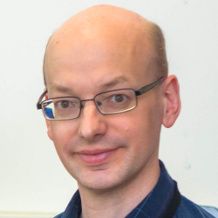Professor Kevin Cowtan
01904 328271
Email: kevin.cowtan@york.ac.uk
Research
Automated protein structure solution
Structural biology is concerned with the 3-dimensional atomic structure of the molecules of life, which allows us to draw conclusions about what each molecule does and how it does it. This enables us to better understand the functioning and regulation, of complex biological systems such as the human body. Atomic structure can be determined by methods such as X-ray crystallography and cryo-electron microscopy (cryo-EM). We write software which helps structural biologists in determining molecular structures.
In the case of X-ray crystallography, the structure solution process involves a number of stages, starting with the laboratory based step of crystallisation and data collection, followed by a number of computational steps involved in the computation of the final atomic model from the X-ray diffraction pattern, via an intermediate stage of a 3-dimensional electron density map. In the case of cryo-EM, electron microscopy images from thousands of molecules in different orientations are combined to produce a 3D image. My particular interests are the application of image processing techniques to reduce the noise level in the electron density maps, followed by automated interpretation of the electron density map in terms of atomic coordinates. I also work with Dr Paul Emsley in the development of new software to visualise, manipulate and validate atomic models.
https://www.youtube.com/watch?v=QGN6tF-zKOE&feature=em-share_video_user
Video demonstration of automated building of nucleotide chains in an electron density map. (This video contains no sound.)
I have authored several high profile crystallographic software packages, including the "dm" phase improvement software, a suite of crystallographic software libraries ("clipper"), image improvement packages ("parrot"), and software for building protein and nucleotide models ("buccaneer" and "nautilus"). All of these are distributed to both academic users and commercial license holders through the CCP4 and or CCP-EM software suites. I also contribute to the "Coot" molecular graphics software of Dr Paul Emsley. I am also involved in training new crystallographers, both through web-based teaching tools, and at international workshops.
Rapid advances in cryo-EM make this is a significant focus of our recent work. Cryo-Em maps present different challenges to X-ray crystallographic maps, typically being lower resolution but less noisy. We are developing new refinement methods with do not rely on being able to see atomic features, which will increase our ability to interpret these maps.
Climate Science
My climate science research focuses primarily on problems which are relevant to the public understanding of climate science. Our first major project was an investigation of biases in historical temperature record and its impact on temperature change over the first two decades of the 21st century. The main temperature record providers showed a slowdown in the rate of warming over this period, however when biases in the temperature record were taken into account, we found that most of the slowdown disappears.
https://www.youtube.com/watch?v=OwKDyiR1f4o&feature=em-share_video_user
Video explanation of the impact of coverage bias on the recent temperature record.
A further contribution to the apparent slowdown in warming arose from a change in the way sea surface temperatures are measured, explained by my colleague Zeke Hausfather of UC Berkeley. More recently we have been investigating the impact of changing observation methods on ship observations from the late 19th and early 20th century, by comparing coastal observations from onshore weather stations and nearby ships.
https://www.youtube.com/watch?v=hnyX32nkYBs&feature=em-share_video_user
Video explanation of the impact of sea surface temperature observation methods on the recent temperature record.
I am now a part of the NERC-funded GloSAT project, lead by the National Oceanographic Centre and UK Met Office. The aim of this project is to extend the historical temperature record back into the 18th century, and to make use of air temperature observations from ships in place of sea surface temperatures. This will help us understand temperature change from before the industrial revolution, as well as the impact of volcanic eruptions in the early 19th century.
Other interests
I am interested in open research and the development of scientific working styles which enhance data re-use. I am a member of the university Open Research Strategy Group. I am also interested in how the social structures of science compensate for subjectivity and cognitive biases of individual researchers.
Teaching
I teach an undergraduate course in the principles of diffraction as part of the core chemistry degree. I teach computer programming to both undergraduates and postgraduates, and am developing a new course which will incorporate basic programming techniques into the core chemistry course for all students. I am interested in barriers to the development of programming skills, and in particular the development of approaches which make programming accessible to the whole cohort. I am also interested in structural biases in science and teaching related to gender and disability.
Selected Recent Publications
- Cryo-EM model validation recommendations based on outcomes of the 2019 EMDataResource challenge.
Lawson, C. L., Kryshtafovych, A., Adams, P. D., Afonine, P. V., Baker, M. L., Barad, B. A., ... & Chiu, W.
Nature methods, 2021, 18(2), 156-164.- Pacific variability reconciles observed and modelled global mean temperature increase since 1950.
Stolpe, M. B., Cowtan, K., Medhaug, I., & Knutti, R. Climate Dynamics, 2021, 56(1), 613-634.- Shift-field refinement of macromolecular atomic models.
Cowtan, K., Metcalfe, S., & Bond, P. Acta Crystallographica Section D: Structural Biology, 2020, 76(12), 1192-1200.- Assessing recent warming using instrumentally homogeneous sea surface temperature records.
Hausfather, Z, Cowtan, K, Clarke, DC, Jacobs, P, Richardson, M, & Rohde R, Science advances, 2017, 3(1), e1601207.

